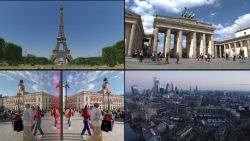Traveling and living abroad sounds exciting, but not if it puts you in piles of debt.
More from Success
However, there are ways to meaningfully explore the world without sacrificing your career or your financial goals.
“If you want to become a global nomad you either need to have a job where you can telework, have enough savings to live on the cheap or have a gig that is generating income along the way,” said Joseph Bautista, a financial adviser at Grow With Joe.
Here are some ways people have made it work for them.
Work remotely and keep costs down
Last Thanksgiving, Bautista’s sister suggested he expand his financial planning business by offering services to Spanish speaking customers. He didn’t speak the language though.Some people might have taken an online language course, but Bautista picked up his Sandy, Oregon-based business and moved it to Mexico.
“The weather is nice, the people are kind and the food is amazing,” he said. “I’m learning Spanish every day and my costs have gone down significantly since I’m earning US dollars and spending pesos.”
And since he was just starting out when he made the move, there were few costs to contend with. He had no employees and he had been working in a co-working space in Oregon, which made it fairly easy to relocate.
Bautista, 33, arrived in Mexico in October. He first ran his business from the city of San Miguel de Allende and now he’s working out of a WeWork office in Mexico City. He plans on stops in Panama and Costa Rica next year, then he’ll move on to Medellín, Colombia.

Nearly every aspect of his new life is being operated through the sharing economy, including the Airbnb where he stays, the Ubers he hires to get around, and his co-working space. The rest of his business is reliant on a good phone and internet connection, since he conducts his meetings through calls and online conference services.
“I love that I don’t own anything,” he said. “You just pay for it as you go. It gives me more freedom and flexibility.”
He says with income of $1,500 to $2,000 a month and an ability to work remotely for less, living in Latin America is possible.
Save up and sign off
Daniel Kopp took eight months off after leaving the Air Force to travel the United States in his RV and visit with family and friends.
“It was strictly no-work time,” said Kopp, who hit 38 states and a dozen national parks along the way. “I stepped away from the fog of work so I could be very intentional about this next phase of life, and a career transition is an ideal point to do that.”
He saved upjust under $30,000over three years to bridge the income gap and fund his expenses, which averaged about $3,600 a month.
“It wasn’t extravagant, but It wasn’t dirt cheap like it would be in some other parts of the world, either.”

He bought an RV to live and travel in. He rented out his house in Idaho and signed up for a health-sharing plan called Medi-Share so he would have nationwide health coverage. Offered through a Christian ministry, the plan’s members share each others’ medical costs.
“I fully understood the tradeoffs I was making between the short-term fun and the gap in income, plus not investing the money I spent along the way.”
Being mindful of these opportunity costs of travel is important, said Lisa Mesquit, a chartered financial analyst at Soaring Investment Management.
“Often, travelers can travel on a budget successfully without using debt,” she said. “But they may not be aware of the lost income, the lost investment returns, the impact to their overall financial plan and possible difficulty in re-entering the workforce when they return.”
Travel that pays for itself
If your work isn’t something you can do remotely and you aren’t able to give up your income altogether, you can take on contract or freelance work in your field to pay for the travel as you go.
Lauren and Steven Keys moved to Hawaii for six months in 2015 and worked on a contract basis with their former full-time employers. Steven, 29, was a high school teacher and Lauren, 30, worked in marketing at a financial firm. While on the road, Steven tutored online and Lauren did aspects of her job that could be done remotely, logging about 10 hours of work per week.
They spent around $1,800 a month, including $965 a month on rent for an apartment in Kailua-Kona, which was across the street from the ocean. They bought a red convertible Mazda Miata (an otherwise impractical vehicle, Steven said, but one that was perfect for their new life) for $4,500. Since they later sold the car for more than they paid for it, they came out about $1,100 ahead.

The couple eventually returned to full-time work in Gainesville, Florida, and bought a condo. But in 2019 they took off again, spending seven months visiting 61 national parks, including in Alaska, American Samoa and the Virgin Islands.
“One of the advantages that you don’t realize until you do it, is that you get to the point where most of your time is spent doing fun stuff,” said Steven. “The time you do spend doing work feels extra good.”
The cost of that trip, which included some expensive flights as well as the purchase of a van that cost $12,300, which they drove and often slept in, was about $2,600 a month per person, or $36,875 total for everything from housing to health insurance over the seven months.
Steven worked 10 hours a week on the parts of his job that could be done remotely and Lauren found some new social media and marketing clients. They both also sold some of their own photography.
“We payed for the trip with the contract work we did along the way,” said Lauren. “And this time, since we had more money in the stock market and we had rental income, we came home significantly richer than when we left.”

























